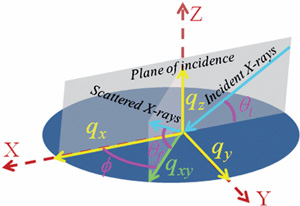| |
The primary purpose of this talk is to illustrate the merits of grazing incidence X-ray scattering (GIXS) techniques inextracting in-plane and out-of-plane structural information from surfaces and interfaces. We shall be able to providean outline of the GIXS techniques in this lecture and the students should refer to extensive reviews and monographs[1–6] written on GIXS for further details. We should also mention here that the X-ray scattering techniques discussedhere can be used with intense neutron sources.
The refractive index of materials in the X-ray energy region is slightly less than unity and this difference increasewith the average electron density of the material under study. Obviously one can determine a critical angle of amaterial below which X-rays will get totally reflected back as the X-ray beam reaches the material surface from itsless dense vapour phase. Around this critical angle X-rays can probe in-plane or out-of-plane structures buried in thematerial surface and the techniques developed for this purpose are known as grazing incidence X-ray scattering (GIXS).GIXS techniques require 'flatness' of a sample, so that scattered X-rays do not get 'blocked' by materials that protrudeupwards due to the macroscopic modulation of the surface. Lower microscopic roughness of a surface/interfaceenables data collection over a larger range and hence more accurate measurements.
 In a typical X-ray scattering measurement X-rays areincident on a sample with angle of incidence and thescattered X-rays are collected with different in-plane andout-of-plane scattering angles as shown in the Figure. Thescattered intensity collected in this geometry then providesus information regarding surface/interface roughness,electron density profiles as a function of depth and in-planestructural and morphological correlation functions. Weshall take few examples to understand the data analysistechniques to extract information from data.
1. J. K. Basu and M. K. Sanyal, Phys. Rep., 363, 1. (2002).
2. J. Daillant and A. Gibaud, X-ray and Neutron Reflectivity: Principles and Applications, Springer-Verlag BerlinHeidelberg, 1999.
3. M. Tolan, X-ray Scattering from Soft-Matter Thin Films, Springer-Verlag Berlin Heidelberg New York, 1999.
4. J. Daillant and M. Alba, Rep. Prog. Phys., , 63, 1725 (2000)
5. M. L. Schlossman, Current Opinion Colloids & Interface Science, 2002, 7, 235.
6. J. Penfold, Rep. Prog. Phys., 2001, 64, 777.
|